Written by Sander Houston
Floods continue to affect wide areas of Zambia. An Early Action Protocol (EAP) aims to mitigate the impact of predicted floods by enabling the release of funding to execute pre-agreed early actions before the flood (a mechanism called Forecast Based Financing).
In the words of Mulambwa Mwanangono, the previous disaster manager of Zambia Red Cross: ‘Anticipation lives on Data, Forecast Based Financing is a function of Data’. Disaster managers need an analysis of the impact of previous floods as understanding what happened in the past is the key to forecasting the possible impacts of future events and planning actions accordingly. Based on historical (hydrometeorological and impact) data, we aim to develop effective flood forecasts and warnings. Forecasts provide a time window of opportunity that enables a proactive approach in which Early Actions can be carried out. Zambia Red Cross Society (ZRCS) performed the first light activation after the IFRC approved the protocol at the end of 2020. Since all activities needed for a full activation of the EAP had not been implemented yet we call this a light activation,
This blog shares insights from the flood light activation in Zambia that took place from February 18th until February 24th 2021.
Background on the Impact Based Forecasting (IBF) Portal and Early Action Protocol (EAP)
ZRCS worked with the 510 data & digital team at the Netherlands Red Cross to analyze and visualize data needed to support operational decisions during the anticipatory actions. ZRCS data analysis is integrated within 510’s Impact Based Forecasting (IBF) Portal. This is an operational decision-making support tool developed to integrate data and visualize the impact a disaster will have. ‘The IBF Portal was operationally used during the activation to visualize and disseminate information that supported the operational decision making of disaster managers’, said Stefania Giodini (team lead of 510). A trigger model, which is used in the portal, is developed to determine at what threshold the Early Action Protocol (EAP) should be activated. The trigger model, also developed in collaboration with 510, is based on the water discharge threshold that corresponds to a 20-year return period flood. When asked about the importance of the IBF Portal Zaitun Munawar (former Program Delegate at ZRCS) said: ‘the IBF portal supports a National Society in a more proactive approach by giving it time to implement early actions’. She continues by saying that ‘by doing so we can reduce the impact on communities and properties’. The EAP is developed collaboratively with all organizations and communities involved to decide on what appropriate anticipatory actions to undertake. ‘This for example includes informing the communities, evacuation of residents, and distribution of water purifying tablets’. Read more about the IBF Portal here.
Organizations involved
The Red Cross Red Crescent Climate Centre provided and played a key facilitation role in the development of the EAP. The Forecast based Action by the DREF, a pool of funds managed at global level by the IFRC to support the activation of EAP, validated the EAP through its validation committee last December and provides funding for the Zambia Red Cross Society (ZRCS) to perform readiness, prepositioning, and the required anticipatory actions included in the EAP once it is activated. This time, since all activities needed for a full activation of the EAP had not been implemented yet, only part of the EAP was activated. T The development of the floods EAP as such, and the simulation exercise to test the EAP is part of a bigger program called Response Preparedness II (RPII funded by the Dutch Ministry of Foreign Affairs ), coordinated by the NLRC and its data & digital team 510 together with the Red Cross Red Crescent Climate Centre. Similar work is taking place in Mali (through the same program) as well as in Ethiopia, Uganda, and Kenya (through the Innovative Approaches to Response Preparedness (IARP) funded by IKEA Foundation), where early warning/early action systems are developed by the host national societies. The local government sectorial offices contributed to both the EAP development as well as light activation. The Disaster Management and Mitigation Unit (DMMU), Global Flood Awareness System (GLOFAS), Water Resources Management Authority (WARMA), and Zambia Meteorological Department (ZMD) also provided technical support.
Activating the Early Action Protocol
When Clayton Lumwaya (GIS Specialist at ZRCS) was asked about the experience with the activation of the flood trigger he said: ‘we have not experienced this amount of rainfall in quite a long time. When the trigger level was reached, the IBF Portal sent an automatic message to the Disaster Management and Mitigation Unit (DMMU).’- DMMU is the governmental stakeholder that provides leadership and coordination in the adoption and implementation of Forecast-based Financing. Clayton continued by saying: ‘When the system showed the risk of floods in the districts we immediately informed all stakeholders and looked into the alert’. His colleague, Wina Wina (Disaster Manager at ZRCS), added: ‘Once we validated the alert the Early Action Protocol could be activated’.
According to Malika Noisette (Response preparedness technical advisor at The Netherlands Red Cross), there were two concerns when activating the Early Action Protocol. The first one being that ‘the ZRCS branch of the area covered by the trigger was not fully equipped yet and therefore not ready to implement all the Early Actions’. The second one was that ‘according to current procedures of the FbA by the DREF, it’s not possible to activate the EAP twice within one season. The rainy season begins in the middle of November and lasts until April. This was a concern since a flood with a higher impact was expected to occur later on in the season and Zambia Red Cross wanted to keep the chance to utilise the FbA by the DREF funds to activate their Early Action Protocol later on, should a bigger trigger be reached in March or April’. Therefore, NLRC looked for internal funds to ensure that this activation takes place while reserving the IFRC’s fund for a potential bigger activation.
Field activities day by day
Day 1 & 2
An intervention area map, which shows the areas where the impact of the flood is expected to happen, was provided via the IBF Portal. The early warning committee was then informed in order to conduct a field study in those areas that would be critically impacted. This way it was possible to contextualize the information of the trigger to the reality on the ground, which is used to determine relevant anticipatory actions. A recommendation was then drafted for all parties involved. Urgent meetings were held to evaluate the situation and options. The available stock was checked along with if the early action activities were ready to be activated. A government letter was sent to inform them that an alert message was received and to ask for the go-ahead to activate the protocol.
Day 3 & 4
The local government was engaged after which clearance from them to continue with the light activation was received. A quick flood assessment was conducted on the ground to determine the flood extent, vulnerabilities, and beneficiaries in conjunction with the DMMU.
Day 5, 6 & 7
The logistics were mobilized and the implementation team assembled. Early actions were executed as the rain continued to fall. Communities were informed on the risk of floods and given information about healthy sanitation practice and safe upland areas. Focus group discussions were conducted in the community and with stakeholders to understand the needs and perceptions of the communities. The flood started on February 24th.
Day 8 – 12
The emergency response phase started after the flood happened.
This included the distribution of Non-Food Ito people affected by the flood.
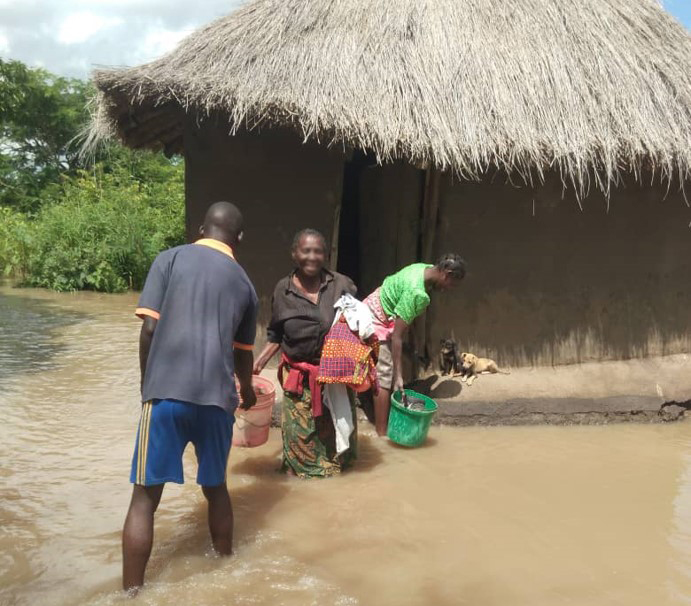
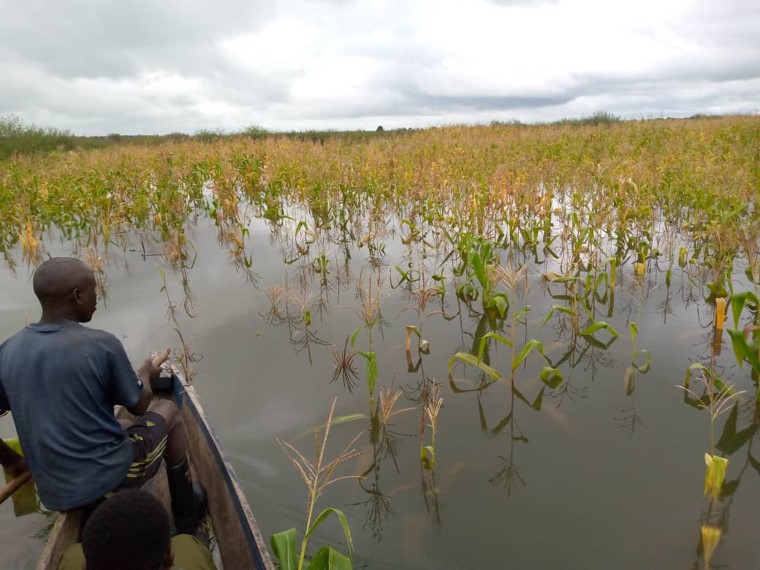
Displacement of households Submersion of crops
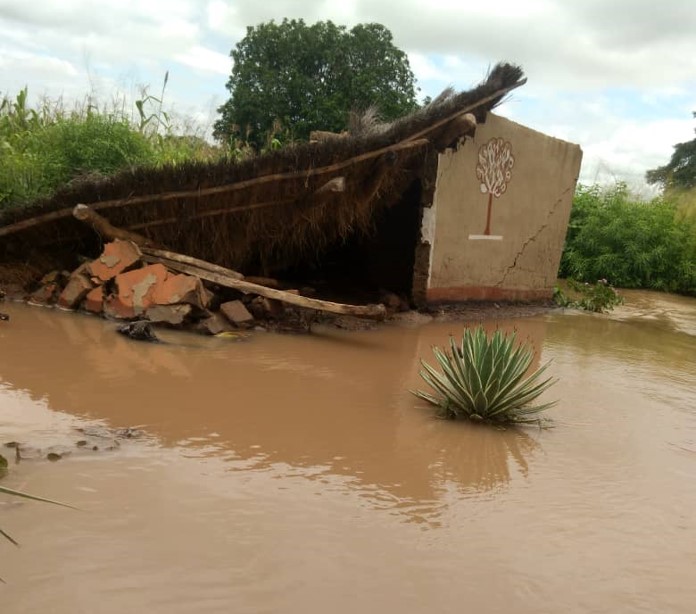
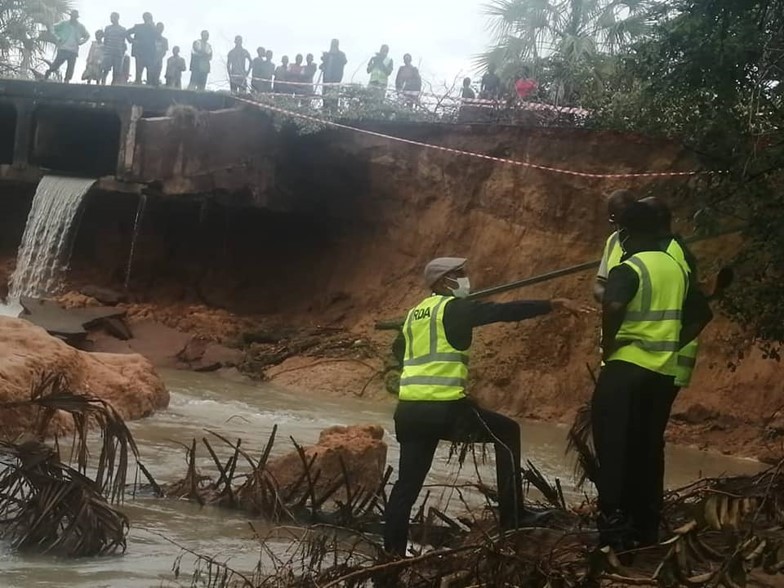
Destruction of shelter Destruction of access routes
What did we learn from the activation?
- It is important to consider alternative funding sources than FbA by the DREF when preparedness activities are not finalized in the disaster areas. Because of the previous collaboration in place, ZRCS and NLRC were able to mobilize resources very fast, but this should be a conversation to have with partners before any activation.
- It was observed that even if preparedness activities were not finalized in the area of intervention, ZRCS could still manage to reposition its stock and mobilize staff and volunteers rapidly.
- Too much time was spent waiting for governmental approval for deployment of actions in the intervention area. Pre-approvals need to be in place for quick processing when the EAP is activated.
- Better collaboration with Ministry of Health, Education, and Agriculture is needed. Especially to expand the capacity of ZRCS reach in the wards where no volunteers are available but coordination structures may already be in place by these ministries, which could be utilised.
- Stakeholders who are initiating the activation should be ready to act before reaching the maximum alert threshold (for example between an 80% to 100% chance of the flood happening) to avoid delay in implementing early actions.
The added value of working with data experts when setting up Forecast-based Financing
510 co-designed and developed the IBF Portal and supports the National Society in the data preparedness journey. Together with the Zambia Red Cross and its data team, 510 initiated the data analysis needed for the development of the Early Action Protocol. The IBF portal proved to be a crucial tool to disseminate information among stakeholders. It acts as a meeting point for the disaster managers from ZRCS and governmental agencies to consult the data, share information and action plans and coordinate the response. Giodini explains: ‘We also knew there is always space for improvements and this was a great occasion to learn: we now know for example that we need to visualize wards on the map so that the disaster manager can decide which one to alert and that we should show elevation so that low lying places can be easily identified. ’
Next steps
510 will now implement the user feedback from this test activation to update the IBF portal. Afterwards, the operational dashboard will be handed over to the Zambia Disaster Mitigation and Management Unit and all stakeholders will have access to it according to their mandate. 510 will continue to support Zambia while it’s moving towards a multi-hazard early warning system that also includes drought anticipation. Noisette adds by saying: ‘The [glossary_exclude]fact[/glossary_exclude] that we were able to do this in Zambia doesn’t mean that we can automatically do this in any country at any given time. We need to learn from this success and ensure that we turn it into a sustainable way of working. One example would be to set a coordinated team of NLRC and 510 experts with clear standard operations procedures, always available to work together in supporting our sister National Societies in quick decision making, in times of alerts and emergencies’.
Image source: Zambia Red Cross Society
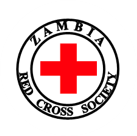
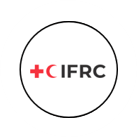
Relevant information about individuals and communities in need can be helpful in providing effective and personalized humanitarian aid. Our data responsibility policy addresses the responsible processing of data with respect to ethical standards and in principles in the humanitarian context, bearing in mind potential consequences and taking measures to avoid putting individuals or communities at risk. Read more on our data responsibility policy here